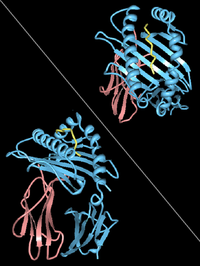
Photo from wikipedia
Systemic Sclerosis (SSc) is a chronic autoimmune disease with high morbidity and mortality. Autologous Hematopoietic Stem Cell Transplantation (AHSCT) is the best therapeutic option for rapidly progressive SSc, allowing increased… Click to show full abstract
Systemic Sclerosis (SSc) is a chronic autoimmune disease with high morbidity and mortality. Autologous Hematopoietic Stem Cell Transplantation (AHSCT) is the best therapeutic option for rapidly progressive SSc, allowing increased survival with regression of skin and lung fibrosis. The immune determinants of the clinical response after AHSCT have yet to be well characterized. In particular, the pivotal role of the Human Leukocyte Antigen (HLA) system is not well understood, including the role of non-classical immuno-modulatory HLA-E and HLA-G molecules in developing tolerance and the role of Natural Killer cells (NK) in the immunomodulation processes. We retrospectively tested whether the genetic and/or circulating expression of the non-classical HLA-E and HLA-G loci, as well as the imputed classical HLA determinants of HLA-E expression, influence the observed clinical response to AHSCT at 12- and 24-month follow-up. In a phenotypically well-defined sample of 46 SSc patients classified as clinical responders or non-responders, we performed HLA genotyping using next-generation sequencing and circulating levels of HLA-G and quantified HLA-E soluble isoforms by ELISA. The -21HLA-B leader peptide dimorphism and the differential expression level of HLA-A and HLA-C alleles were imputed. We observed a strong trend towards better clinical response in HLA-E*01:03 or HLA-G 14bp Del allele carriers, which are known to be associated with high expression of the corresponding molecules. At 12-month post-AHSCT follow-up, higher circulating levels of soluble HLA-E were associated with higher values of modified Rodnan Skin Score (mRSS) (p = 0.0275), a proxy of disease severity. In the non-responder group, the majority of patients carried a double dose of the HLA-B Threonine leader peptide, suggesting a non-efficient inhibitory effect of the HLA-E molecules. We did not find any correlation between the soluble HLA-G levels and the observed clinical response after AHSCT. High imputed expression levels of HLA-C alleles, reflecting more efficient NK cell inhibition, correlated with low values of the mRSS 3 months after AHSCT (p = 0.0087). This first pilot analysis of HLA-E and HLA-G immuno-modulatory molecules suggests that efficient inhibition of NK cells contributes to clinical response after AHSCT for SSc. Further studies are warranted in larger patient cohorts to confirm our results.
Journal Title: International Journal of Molecular Sciences
Year Published: 2022
Link to full text (if available)
Share on Social Media: Sign Up to like & get
recommendations!